Maritime Cranes Market Research: 2032
The Global Maritime Cranes Market Size was valued at $2,794.5 million in 2020, and is projected to reach $4,590.5 million by 2032, registering a CAGR of 3.8% from 2023 to 2032. Furthermore, in terms of volume, the global maritime cranes market was valued at 45,157 units in 2020, and is projected to reach 65,026 units by 2032, registering a CAGR of 2.7% from 2023 to 2032. A maritime crane is a type of crane used for lifting and handling loads in oceans, seas, and large lakes, and other water bodies. Maritime cranes are commonly found on ships, offshore platforms, barges, and offshore platforms, and are widely used for loading and unloading cargo and transferring supplies and equipment between two vessels or offshore platforms.
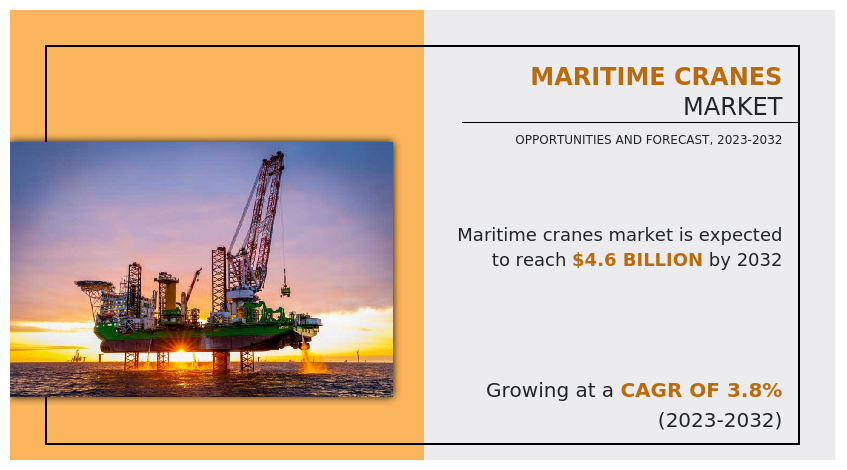
Market Dynamics
The maritime cranes market is primarily driven by various factors including the rise in demand for oil & gas to produce transport fuels such as petrol, diesel, jet fuel, and various other products including lubricants, and petroleum jelly. Maritime cranes are extensively used on offshore oil & gas rigs for cargo handling, and various other items required for offshore operations. In addition, these cranes are used for unloading and loading oil & gas exploration equipment to and from the sea. In addition, another type of maritime crane also known as ship cranes are used for various applications during oil & gas extraction, including the construction of oil & gas rigs, and their maintenance & repair.
According to a report from the International Energy Agency (IEA), the consumption of oil is anticipated to increase from 99.7 million barrels/day in 2019, to 105.1 million barrels/day by 2026. Thus, growth in the oil & gas industry driven by rising demand for fuel is greatly anticipated to positively influence the growth of the maritime cranes market. Moreover, for the construction of offshore wind farms, a maritime crane is an essential piece of equipment that is used for lifting heavy pieces of the windmill and erecting them in the middle of the ocean. Most countries across the world have set ambitious targets to reduce their carbon emissions and become net zero by 2050, which is expected to drive demand for maritime cranes which is extensively used in the construction and repair of offshore farms. Growth in these sectors will further be affected by the rising global population, as an increase in population will certainly drive demand for renewable as well as non-renewable energy sources. According to data from the United Nations, the global population was 8 billion at the beginning of 2023, and is expected to increase to 9.7 billion by 2050. Countries in the Asian and African continents are projected to play an important role in global population growth and urbanization.
Apart from the use of maritime cranes in the construction of oil and gas rigs and offshore wind farms, they are also used for various other functions such as for recovering or salvaging stranded ships, goods, and other equipment from the ocean; eventually, reducing the scale of total financial loss of the companies operating in maritime industry. Moreover, transshipment activities, which include the loading and unloading of goods from one ship to another to reduce the overall cost of shipment of any goods are also performed using maritime cranes. In addition, transport ships, research ships, fishing vessels, and others are also installed with maritime cranes so that goods and equipment can safely be handled on the deck or can easily be lowered and lifted to and from the ocean. Furthermore, coast guard organizations of different countries also make significant use of maritime cranes. Thus, such versatile application of maritime cranes is a primary factor for the growth of the maritime cranes market.
However, the high operational and maintenance cost of maritime cranes is expected to restrain the market growth. For example, maritime cranes are susceptible to damage such as corrosion, mechanical wear & tear, hydraulic & electrical system issues, structural damage, and various others due to harsh marine environmental conditions which include high waves, storms, rains, and others. Therefore, continuous and periodic inspections and maintenance & repair activities on these cranes are important to keep them working and safe to operate at all times.
Moreover, technological and other developments in maritime cranes are among many maritime cranes market opportunities for the growth of the key players. For example, technologies such as Artificial Intelligence (AI), the Internet of Things (IoT), cloud connectivity, and others are being incorporated into the maritime cranes. For instance, in April 2022, Palfinger Marine received an order to build and further develop technology for remote-controlled cranes from Norway-based oil exploration and development company, Aker BP.
The maritime cranes market has witnesses various obstructions in its regular operations due to COVID-19 pandemic and inflation. Earlier, the worldwide lockdowns resulted in reduced industrial activities, as well as reduced activities in offshore oil and gas production eventually leading to reduced demand for maritime cranes. However, COVID-19 has subsided, and the major manufacturers in 2023 are performing well. Contrarily, the rising global inflation, is a new major obstructing factor for all industries including oil & gas, and maritime trade. The inflation, which is a direct result of the Ukraine-Russia war, and few long-term impacts of the coronavirus pandemic, has introduced volatility in the prices of oil and gas, and it is expected that the prices will further decline in the coming months as the recession worsens.
In addition, in the coming months, a decline in fuel consumption of fuel is also expected to be witnessed, which will negatively impact the offshore oil and gas production sector, eventually negatively impacting the maritime cranes market. The countries that are expected to be badly affected by the recession are countries in Europe, Latin America, the U.S., and Africa. However, India and China are performing relatively well. Furthermore, a fluctuation in commodity prices such as steel and other metals is also expected to have a negative impact on the manufacturers of maritime cranes. In addition, inflation is expected to worsen in the coming years, as the possibility of the ending of the war between Ukraine and Russia is less. However, with the continued talks between different countries, a peace agreement between Ukraine and Russia can be devised.
Segmental Overview
The maritime cranes market is segmented on the basis of boom type, capacity, application, and region. By boom type, the market is bifurcated into lattice boom, and telescopic boom. Depending upon the capacity, the market is categorized into up to 10 tons, 10 tons to 100 tons, 100 tons to 300 tons, and above 300 tons. On the basis of application, it is divided into oil & gas rigs, construction vessels, fishing vessels, and others. Region wise, it is analyzed across North America (U.S., Canada, and Mexico), Europe (Germany, France, Italy, UK, and rest of Europe), Asia-Pacific (China, India, Japan, South Korea, and rest of Asia-Pacific), and LAMEA (Latin America, Middle East, and Africa).
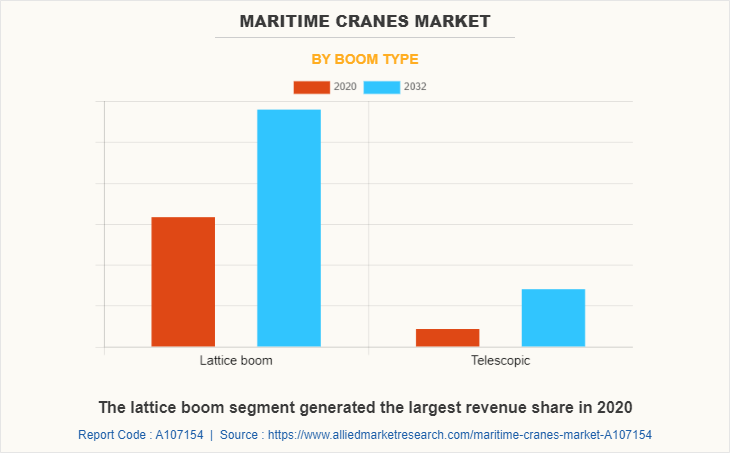
By Boom Type:
The maritime cranes market is bifurcated into lattice boom, and telescopic boom. In 2022, the lattice boom maritime cranes segment dominated the maritime cranes market share, in terms of revenue, and the telescopic boom maritime cranes segment is expected to grow with a higher CAGR during the forecast period. Lattice booms are made using truss that decreases the total weight of the boom while still providing maximum support for heavy loads. The demand for maritime cranes with lattice booms has been increasing due to the increase in demand for offshore wind farms which involves handling heavy towers, blades, turbines, and others. On the other hand, high demand for telescopic boom is owing to its ability to easily extend and retract the boom allowing for greater reach and making it possible to lift loads to higher or farther positions.
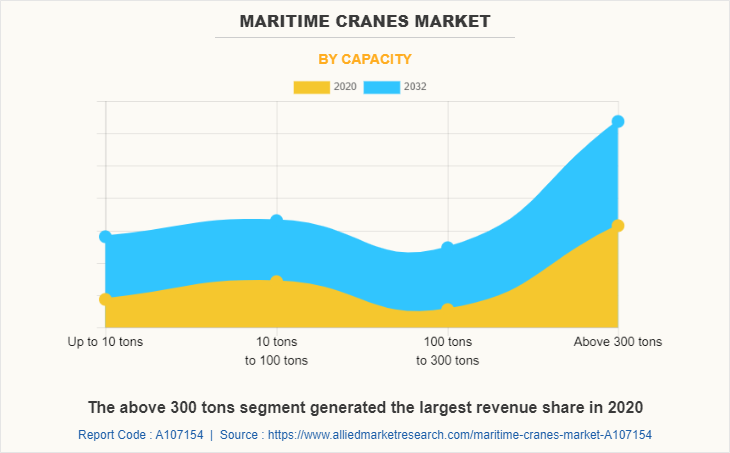
By Capacity:
The maritime cranes market is divided into 10 tons, 10 tons to 100 tons, 100 tons to 300 tons, and above 300 tons. In 2022, the above 300 tons segment dominated the maritime cranes market, in terms of revenue, and the 100 tons to 300 tons segment is expected to witness growth at a higher CAGR during the forecast period. The revenue generated by cranes with a capacity above 300 tons is highest among the all the types, owing to their large-scale application in heavy lifts such as for erecting wind farms, as well as for the construction of oil and gas rigs.
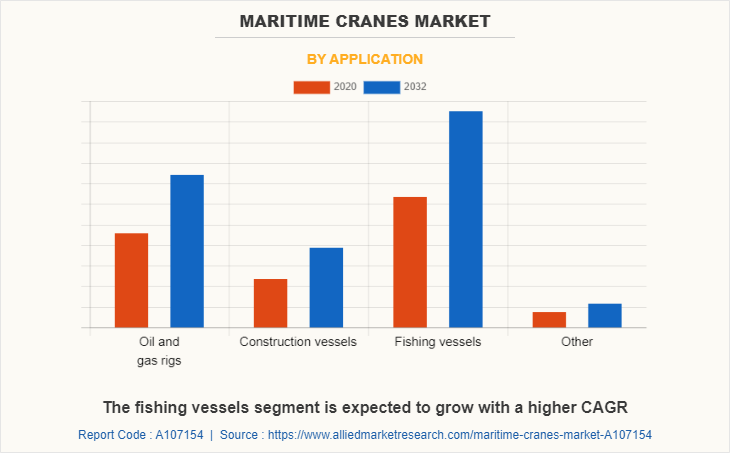
By application: The maritime cranes market is categorized on the basis of oil & gas rigs, construction vessels, fishing vessels, and others. The fishing vessels segment accounted for a higher market share in 2022, and the same segment is anticipated to grow with a higher CAGR throughout the forecast period. This is attributed to the high demand for seafood in countries such as China, Japan, and South Korea. In addition, Europe is also anticipated to drive the demand for seafood in the coming years.
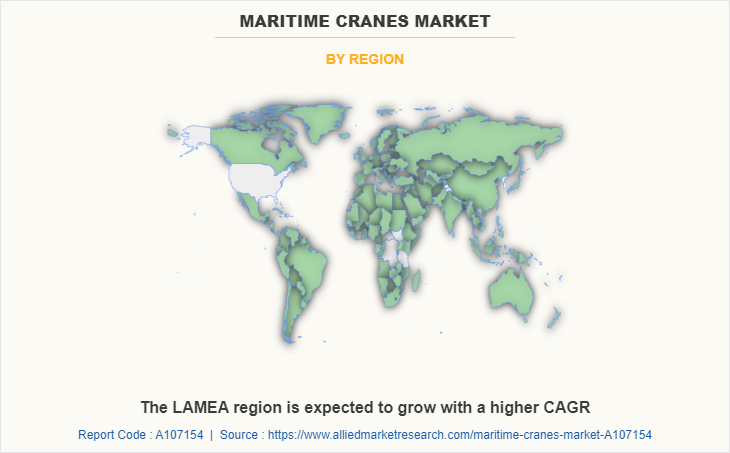
By Region:
Asia-Pacific accounted for the highest market share in 2022 and LAMEA is expected to dominate the maritime cranes market forecast by growing with a higher CAGR throughout the projected period. Asia-Pacific is among the largest ship and marine equipment manufacturing industries. According to the Statista, in 2021, China received 49% of all the ships constructed that year in the world. Thus, owing to high number of ship-building activities in the region, the demand is high for maritime cranes which are often installed on the ships and barges. Furthermore, the growth of the population in the region which is expected to stress the existing energy, shipping, and fishing infrastructure is expected to boost the development of new infrastructure; thereby, providing opportunities for the maritime cranes market growth.
Competition Analysis
Competitive analysis and profiles of the major players in the maritime cranes market are provided in the report. Major companies in the report include Cargotec Corporation (MacGregor), Heila Cranes Ltd., Huisman Equipment B.V., Kenz Figee, Liebherr-International AG, NOV INC., PALFINGER AG, PLM Cranes B.V., Seatrax Inc., Sormec s.r.l. Major players to remain competitive adopt development strategies such as product launch, collaboration, and others. For instance, in 2020, Palfinger Marine, a large manufacturer of maritime cranes and machinery, supplied three telescopic boom cranes to a live fish carrier owned by a Norwegian company. Such factors are expected to positively influence the growth of this segment.
Key Benefits for Stakeholders
- The report provides an extensive analysis of the current and emerging maritime cranes market trends, and historic data.
- In-depth maritime cranes market analysis is conducted by constructing market estimations for key market segments between 2022 and 2032.
- Extensive analysis of the maritime cranes market is conducted by following key product positioning and monitoring of top competitors within the market framework.
- A comprehensive analysis of all the regions is provided to determine the prevailing opportunities.
- The maritime cranes market revenue and volume forecast analysis from 2023 to 2032 is included in the report.
- The key players within the maritime cranes market are profiled in this report and their strategies are analyzed thoroughly, which helps understand the competitive outlook of the maritime cranes industry.
Maritime Cranes Market Report Highlights
| Aspects | Details |
| Market Size By 2032 | USD 4.6 billion |
| Growth Rate | CAGR of 3.8% |
| Forecast period | 2020 - 2032 |
| Report Pages | 193 |
| By Capacity |
|
| By Application |
|
| By Boom Type |
|
| By Region |
|
| Key Market Players | Heila Cranes S.p.A., Seatrax, Inc., Kenz Figee, Huisman Equipment B.V., Liebherr-International AG, PLM Cranes B.V., NOV INC., Sormec s.r.l., Cargotec Corporation (MacGregor), PALFINGER AG |
Analyst Review
The maritime cranes market has witnessed significant growth in the past few years owing to an increase in offshore construction activities, a rise in global trade, and increased demand for fuel.
Moreover, in the coming decade, companies in the maritime industry will primarily focus on decarbonizing their fleets. This is also estimated to affect the maritime cranes market. For instance, in May 2019, Sembcorp Marine, build the world’s biggest semi-submersible crane vessel. The crane is equipped with dual-fuel engines running on Marine Gas Oil (MGO) and Liquefied Natural Gas (LNG). In addition, Government support for the construction of offshore wind farms is driving the demand for heavy-duty maritime cranes.
However, geopolitical tensions and increase in fuel prices are among the few concerning issues in the maritime industry, this will negatively affect the maritime industry including the maritime cranes market. Contrarily, the incorporation of advanced technologies such as AI, IoT, cloud connectivity, preventive maintenance, and others is expected to have a positive impact on market growth.
Key factors driving the growth of the maritime cranes market include a rise in demand for oil & gas, increasing off-shore wind turbine fields, and various advantages of maritime cranes.
The latest version of the global robotic Maritime Cranes Market report can be obtained on demand from the website.
The global maritime cranes market was valued at $2,794.5 million in 2020.
The global maritime cranes market is projected to reach $4,590.5 million by 2032, registering a CAGR of 3.8% from 2023 to 2032
The forecast period considered for the global Maritime Cranes Market is 2023 to 2032, wherein, 2022 is the base year, 2023 is the estimated year, and 2032 is the forecast year.
Asia-Pacific is the largest regional market for Maritime Cranes.
Major companies in the report include, Cargotec Corporation (MacGregor), Heila Cranes Ltd., Huisman Equipment B.V., Kenz Figee, Liebherr-International AG, NOV INC., PALFINGER AG, PLM Cranes B.V., Seatrax Inc., Sormec s.r.l.
The report contains an exclusive company profile section, where leading companies in the market are profiled. These profiles typically cover company overview, geographical presence, market dominance (in terms of revenue and volume sales), various strategies, and recent developments.
Loading Table Of Content...
Loading Research Methodology...



